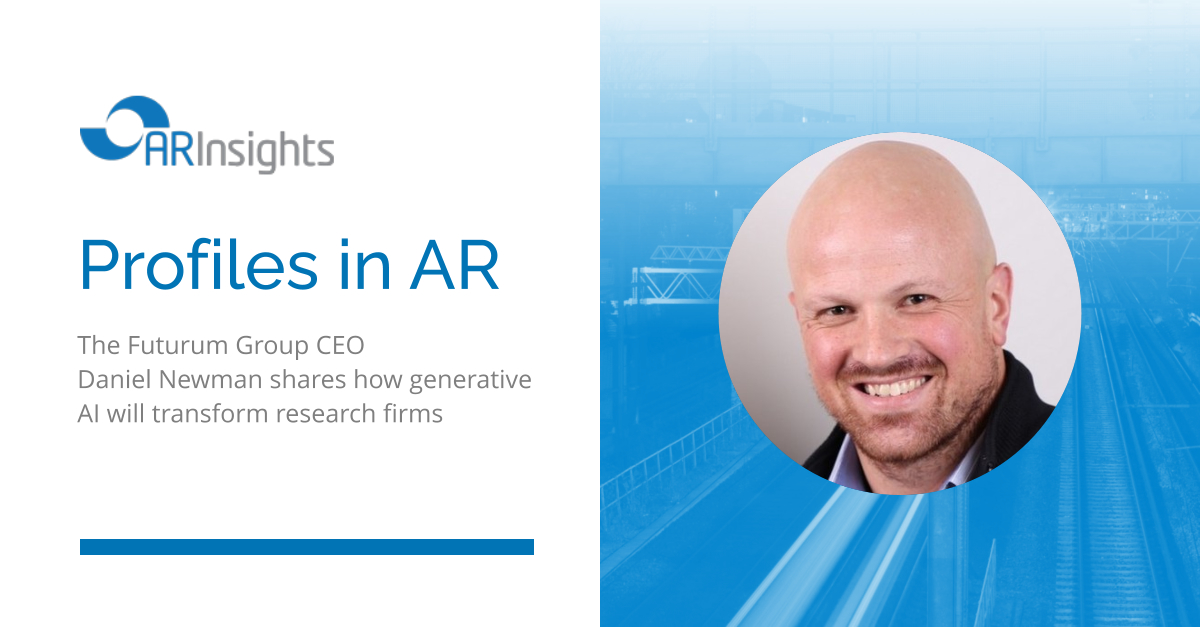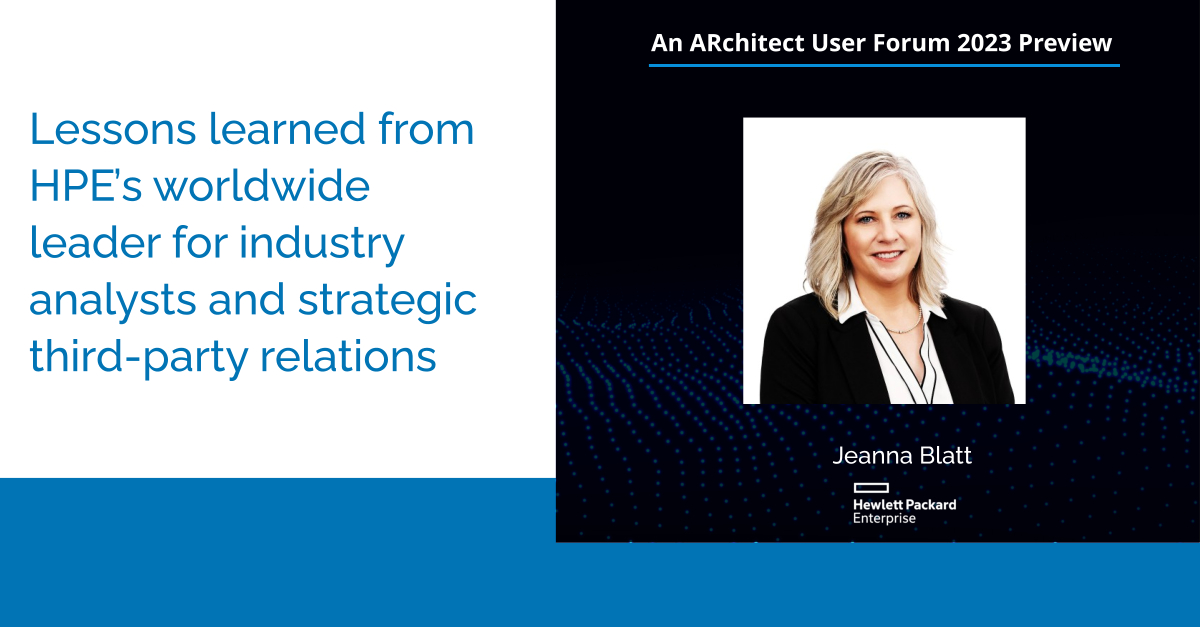Many analyst relations (AR) pros and their companies hear frequent, positive “buzz” about The Futurum Group (and its research arm, Futurum Research) — as it’s expanded its services through recent acquisitions and continues to disrupt traditional research firm models. Frequently sought after for their insights, Futurum analysts are prominent fixtures in the ARchitect Power 100, a ranking of the most influential industry analysts worldwide across all technology markets.
Those are just a couple reasons why we were thrilled to speak to Daniel Newman, CEO of The Futurum Group, for our Profiles in AR series. A frequent presence on Bloomberg, CNBC, Forbes, MarketWatch and more, Daniel has written seven books (including the prescient Human/Machine: The Future of Our Partnership with Machines) and is attuned to the latest technology trends and their implications.
Daniel also has the ear of dozens of tech CEOs worldwide, who lean on his insights and advice as they develop product roadmaps and go-to-market strategies, and get his gut check about their direction. It’s for that reason that, among many in the sector, he’s considered the “CEO Whisperer.”
Read on for Daniel’s fascinating insights — spanning Futurum’s recent acquisitions and plans for the future, best practices when engaging with Futurum (and other) analysts, how generative AI is upending business models, and a lot more.
Q: Can you tell our readers more about Futurum Research and how you’re different from other firms?
Daniel: Futurum Research was born in 2016 out of the idea that analyst research and analyst relations models were going to see a significant paradigm shift in the wake of digital transformation. What’s more, where buyers go to get information, buyer-seller parity, who’s influential, and the fact that everyone can now build their own content platform — those were all trends coming to the fore that we factored into our business.
And it’s paid off. In a short period of time, and through pioneering a new model for AR, we’ve grown well over 200 client relationships by being a little different. That is, we’re a bit faster and more agile than other firms, more disruptive, more technology-led and more attuned to the amalgamation of media, social media and the broader definition of influencers: encompassing pundits, thought-leaders, professors and more. And with the recent generative AI movement, we’re going to see another major wave of change come to the industry that will impact our business and our clients’ businesses as well.
Q: Congratulations on a busy, successful last couple years — with the acquisitions of Dash Network and Evaluator Group this year, and Wainhouse Research last year. How are these acquisitions strategic to the Futurum brand, and how do your customers benefit from this expanded portfolio?
Daniel: Our acquisition strategy always factors in two things: the technology or product, and the people. In all three cases, we had great fits.
We also looked at the fact that there were some really great research firms out there that probably weren’t getting valued or utilized as well as they could be — largely because of those shifts I mentioned taking place to more regional, social and influence-led models. And we’re very influence-led ourselves: We put highly knowledgeable and recognizable faces in analyst roles, and amplify their content across social and other digital channels.
At Wainhouse, they had really tremendous intelligence, especially related to collaboration. We saw opportunities for content syndication and to power a subscription- and SaaS-based offering. Dash Network had strong capabilities in the customer experience, employee experience and apps markets. They were a pretty young company, but had well-established leaders and great people.
And then Evaluator had a ton of technical competencies, capabilities and wonderful people as well. While its business model had aged a little, its capabilities and knowledge hadn’t aged a bit. We knew that if we could layer our digital and social amplification to the products and services they offered, we could drive greater visibility and performance.
As we’ve assimilated the companies, cultures and offerings, we relaunched our business last month as The Futurum Group. Instead of running all these different acquired companies separately, we rolled up everything to create four business units: Futurum Research, with in-depth research and insights on global technology markets; Futurum Labs, with testing and validation services; Futurum Intelligence, with a subscription model to syndicated market studies; and Futurum Network, a digital media platform with demand generation opportunities. The Futurum Group also includes The Six Five, a joint venture with Patrick Moorhead of Moor Insights and Strategy, and will have a few more components added shortly.
Q: Can you tell us more about Futurum’s expansion plans and market objectives — and any other key priorities?
Daniel: We’re growing fast: We went from just a few people to nearly 100 people in just a few years. We have big ambitions for the company; those three acquisitions won’t be our last. I see us being a company that’s going to continue to invest and buy the best firms that have really great assets. We’re going to keep building our intelligence and keep building Labs. We want to be at the top of the food chain of the most influential analysts.
As we’ve scaled, we’ve taken an inside-out approach. We’ve looked at: How do we create scale and do every process faster? We’ve been — and will continue to be — extremely technology-led. We’ve made big investments in our back office, ERP, CRM, and project management tools, among others. We plan to build out a lot of tools and technologies to give our customers even greater transparency.
As a leader, I really believe in transparency in our own business, too — sharing insights into our vision, plans and strategy, so everyone understands what we’re trying to do and be. Data plays a substantial role in forming approaches, direction and ultimately decision-making.
We’re not trying to be an “old-guard,” large research and analysis firm. That model is aging, and it’s not going particularly well. So, that’s really where automation and generative AI come into play to drive modernization. Nowadays, people want tools that they can ask questions to, using natural language, and instantaneously get access to relevant data. They’re going to want a more on-demand, technology-led experience with the ability to get relevant recommendations and content put in front of them.
So, we’re going to continue to be a very transparent, accountable firm that focuses on technology, so customers can answer: “How much is this content being read?” “Who’s reading it?” “How impactful is it?” “Is it driving meaningful demand?” Because when a company spends money to commission a research asset, they want to know if they’re getting value. Yet in this industry, historically, analyst firms have left an opportunity for that gap to be filled.
So, we understand what customers want; we understand where the market is going in terms of research, analysis, analytics and advisory; and we are planning and continuing to invest to leverage technology to allow us to stay fast and lean. We’ll add, very strategically, the highest quality and most influential headcount, as we don’t want to get oversized in a way that makes us slow. That’s the biggest complaint we hear about larger firms — that they can be slower to react. So, we have to continue to build our engine to be nimble, fast and scalable, and to meet customers where they are today.
Q: As an analyst who’s consistently atop the ARchitect Analyst Power 100 list, you interact with a large number of AR pros and ARchitect users. What’s your day like; how many meetings do you typically take? What topics are companies most interested in picking your brain on?
Daniel: I’m very excited about what’s at the forefront of the technology landscape at any given time, and my daily routines very much give that away. I probably spend time speaking to 50-75 CEOs on a quarterly basis. On a daily basis though, I could be on the road, on stage or at a conference venue. No matter where I anchor myself, my days will always include a very early start and a very late end, with dozens of interactions and conversations with clients, business leaders, reporters or tech enthusiasts who meet me — especially at conferences — and want to understand the “who’s who” and “what’s what” of the current landscape. The media, for instance, can’t get enough of the fast-moving tech and innovation pace, which directly affects markets. The interviews I conduct in broadcast networks usually touch on at least a couple such market-movers who sit at the intersection of business, tech and influence.
I’m often asked to be a synthesizer or translator of tech companies to investor communities. That’s a little unique because analysts typically focus on industry or equities. But right now, the two are hyper-dependent on one another. Investors want to understand that companies are building highly capable and market-leading technology stacks. And the equities folks don’t always know the tech involved. And then, of course, the tech folks tend to not follow the markets very closely — but the markets drive a lot of decisions.
I also speak with companies about leading-edge technology trends. Like when a company needs to have an analyst help them understand generative AI, or 10 years ago, digital transformation. They need someone who can talk about the technologies and their impact through a business lens because you don’t buy tech to solve tech problems — you buy it to solve business problems. I often have technology conversations with CEOs and executive leadership teams around key topics in our 12 practice areas.
What’s driven all the interactions with myself and our broader team is the fact that we give great advice. Companies want to talk with us on their earnings day, investor day, and when they launch new products or make an acquisition. They know we’ll give them good feedback, and help them understand how to position their offering and tell their story to the market. And they also know that we will be sought by the press and other third parties for our opinion — so they want to make sure we have the information right. We have a great reputation for synthesizing and sharing market commentary.
We also employ the most capable, aware and knowledgeable insiders to help us understand what’s going on: so we can provide that inside voice and perspective, and give clients straightforward, direct, no-BS feedback.
Q: Based on your interactions with AR pros, do you have any analyst relations pet peeves?
Daniel: Probably my biggest pet peeve is when people ignore the “relations” part of analyst relations. We’re an analyst firm; your job as an AR pro is to build a relationship with us.
We prioritize client relationships and projects ahead of prospective ones — while still working to build new relationships every day. And as we build client relationships, one of the most frustrating things is when AR folks are purely transactional, just showing up when they need something. For instance, they might reach out 15 times when they need a comment for press or when they’re launching a new product or preparing their earnings report. “Can you cover us?” “Can you talk about us?” “Can you do a briefing?” But then when we have a question or need, they become unresponsive.
My point is: Are we building a relationship here, or are we just transacting with one another?
Q: What do you consider to be excellent analyst relations? What are some best practices for AR pros engaging with Futurum?
Daniel: The main thing is checking all the boxes: providing quick responses and access to the executives or information that we need, involving us in relevant briefings, notifying us about analyst days in advance and asking for feedback — not just talking at us all the time.
And it’s also being strategic with your AR program and disrupting the status quo when needed. What’s worked for an analyst relations program for 10 years may need to be done differently right now. That includes the way companies define “analysts.”
I still see companies that will say, “Oh, because you talk to the press, or because you write on Forbes, you’re not an analyst. You’re something else.” Maybe a decade ago, that was the case; even five years ago, it was arguable. But the analyst model has changed, and AR team members who are stuck in that 2010 mentality are going to struggle to be relevant and successful. You have to accept there is a new paradigm in the business.
Q: Can you tell us about Six Five Media, your joint venture with Patrick Moorhead of Moor Insights & Strategy? Why is this media network unique?
Daniel: Patrick and I are, first of all, good friends; we became so when we were both hosts at Dell World in 2014. At the end of the event, we had a beer together and talked about what we did. We both were interested in disrupting the traditional analyst model with digital media. A year-and-a-half later, when I launched Futurum Research in 2016, Pat was an advisor to the business — and he has been ever since.
Then, in 2019, we created The Six Five Podcast. It was actually inspired by an ESPN show where people would ask questions and score the answers. We didn’t quite pull that off in terms of the gamification — but we did pull off a similar structure where we explored six topics for five minutes each. We did a deep analysis of the news, rather than reporting on the news itself.
Then with COVID, as business models changed, we looked at monetizing the podcast. So, in March of 2020, we offered sponsorships for 10 episodes. They sold within an hour. We saw that our customers were eager to work with us — and so that was the origin of Six Five as a media company, not just a podcast. We did our first Six Five Summit that year, keynoted by Michael Dell, and are about to do our fourth installment soon. Our upcoming, virtual summit (June 6-8, 2023) will be opened by Broadcom CEO Hock Tan and feature many other terrific executive speakers.
So, our trajectory for Six Five Media went from doing a podcast to a paid podcast and an event, and then we created a whole media network. Now, we also do what’s called “On the Road,” where we take our podcast to events and do interviews from within booths: still focusing on analysis, rather than straight news. We also recently announced a new addition to our team: Diana Blass, a broadcast journalist and technology reporter, who’ll host a podcast called “Connected with Diana Blass” on our network, where she’ll also explore generative AI topics.
So, my vision for the Six Five is that it’s also going to become a bigger entity: more shows, more content. We really want to be the guiding force of analysis using new media and new means of reach, amplification, distribution and influence.
Q: What disruptive technology trends should be on companies’ radars right now?
Daniel: I don’t think there’s any trend right now that’s more disruptive than generative AI — for companies at large and for research and analysis firms too.
Accordingly, we are looking internally at every single way that automation, AI and generative AI could change the way we do business and content operations at Futurum. For example, should we be writing our own blogs? Should we be doing them with generative AI? Should we be creating our own social posts, and doing our own SEO, proposals and follow-ups? We’re also looking down the stack at things like: What are additional ways that customers can find out our perception on something? When they want to get our sentiment about a product or service, should we be training models in AI, based on our thousands and thousands of articles, podcasts, television appearances and tweets — so they can comb through the data and tell others what we think?
In the future, that kind of technology is going to be incredibly disruptive. There are going to be new things, new opportunities and new work that will come from the elimination of the old work. The way we do reports and create research notes, blogs and social content — it’s all going to change. It should be able to be done faster, more accurately and in a way that’s more on brand.
So, I think the overall industry is going to see a major pivot in the next 12-to-24 months. Our own firm will have a different model for making money within two or three years. Analyst firms that don’t have disruptive, AI-driven content operations are going to be really struggling to survive.
I haven’t seen a force in my career that’s moved as fast as generative AI or that I’m as excited about. I think it’s going to be a watershed moment for the analyst industry because I don’t think the industry, as a whole, is built to be lean. It has lots of people, lots of chairs, lots of meetings, lots of interactions. It takes a long time to move the needle. And so, we’re going to be the kind of firm that looks more like technology, which is evident in our recent announcement of Futurum.AI, which will launch later this year, and while it’s early days… we believe this is the beginning of a revolution for this business.
***
Many thanks to Daniel for sharing his time and insights! If you’d like to connect with Daniel, you can reach him on LinkedIn.
And stay tuned for additional Profiles in AR.



